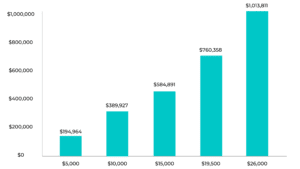How much do you need for retirement? Well, investment research firm Morningstar has a handy but somewhat scary stat: $1.18 million. Using average annual returns of 6 percent and pegging inflation at 2.5%, Morningstar calculates that’s the amount of savings needed to achieve $40,000 per year in annual income for 30 years.1
If your retirement assets aren’t quite on track to meet that goal, there are two financial strategies that can help – and they both have additional tax benefits. We take a close look at the IRS’s Catch-Up plan and Health Savings Accounts.
Key concepts we cover: IRS Catch-Up Plan, Health Savings Accounts (HSAs) and the concordant tax benefits.
If You’re Over 50 and Underinvested, the IRS Can Help
According to investment management firm Fidelity, in the first quarter of 2019, Americans with 401(k) plans aged 50-59 had on average $174,100 saved. That $800K shortfall sounds like an impossible journey to cover before retirement, but there is a way to get there. Thanks to what the IRS calls the “Catch-Up” contribution, employees 50 and over are allowed to contribute an additional $6,500 per year to a 401k plan. That additional money invested over time has significant impact on the total value of a retirement plan invested from age 50-70.
The Importance of Catching Up
As can be seen in Chart 1, a $5,000 contribution results in retirement savings of $194,964 over 20 years. However, the maximum gets you to $760,358 – and the max-plus the “catch-up” brings you to $1,013,811. At the end of the day, that extra $253,453 can go a long way towards the cost of living, travel and medical bills.
Chart 1: Savings Rates Matter – A Lot

Source: Seven Group
For all calculations, we are assuming retirement at 70 years old to increase both income, savings and Social Security benefits. We’ve looked at the impact that different levels of savings have on your plan over time, assuming a 6 percent annual return rate. The maximum level of allowed contributions is set annually by the IRS and tends to increase every year, but we’ve kept it stable at the current rate of $19,500 per year, plus the $6,500 catch up.
How Do Taxes Play into This?
The other side to our 401(k) contribution story is the tax impact. Taking $26,000 per year (the maximum contribution of $19,500 plus the $6,500 catch-up) out of disposable income and putting it to work in savings can seem like a big sacrifice. However, since traditional 401(k) contributions are made with pre-tax dollars, the tax savings can be substantial. Taxes on traditional 401(k) contributions are deferred and paid during retirement, when lower income can result in a lower tax bracket.
An Underappreciated Extra – Health Savings Accounts Are Not Just for Medical Expenses
Health Savings Accounts (HSAs) are a way to save and invest dollars that are earmarked for medical expenses. As you move into the 50s and beyond, these types of accounts become even more critical. They were created to be used alongside High Deductible Health Plans (HDHP) to provide savings to cover the deductible (that’s the one caveat – you must have a HDHP to qualify for one).
These accounts provide tax-advantaged savings for current or future medical expenses, including deductibles, co-insurance, prescriptions, vision expenses, and dental care. In certain circumstances – for instance, if you need to use COBRA coverage to bridge a gap in healthcare, they can also be used for premiums. Unused balances are carried over to the following year, funds never expire, and they can be passed on to a beneficiary after death.
HSAs Have Significant Tax Advantages
HSAs are typically referred to as having a “triple tax advantage”, because accounts are funded with pre-tax dollars; interest or investment growth is not taxed; and if used for qualified medical expenses, withdrawals are not taxed. However, if you do use withdrawals for non-medical expenses, they are taxed at your regular rate and there is no penalty.
…And There’s a Catch-Up
The maximum contribution for an individual in 2020 is $3,550, and for a family it’s $7,100. If you are over 55, you can contribute an additional $1,000 to either the individual or family maximum. All of these work together to ensure you’re covered for any regular or surprise health expenses.
Bottom Line
Even if you are currently underfunded, your financial advisor can help you formulate a plan to get there in time for a successful retirement. Working together with you, they’ll implement tax-advantaged savings and investing strategies that will put your money to work and get you on track.
1. Maranjian, Selina. Wake Up! This Is Your Financial Wake Up Call. The Motley Fool. July 21, 2019.



